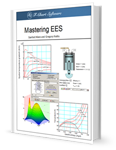Description of EES
There are several major differences between EES and other equation-solving programs. First, EES allows equations to be entered in any order with unknown variables placed anywhere in the equations; EES automatically reorders the equations for efficient solution. Second, EES provides many built-in mathematical and thermophysical property functions useful for engineering calculations. For example, the high accuracy steam tables are implemented such that any thermodynamic property can be obtained from a built-in function call in terms of any two other properties. Similar capability is provided for most refrigerants, ammonia, methane, carbon dioxide and many other fluids. Air tables are built-in, as are psychrometric functions, JANAF data for over 1200 substances, and property data for hundreds incompressible solids and liquids including heat transfer fluids and brine solutions. Transport properties are also provided for all substances.
An extensive heat transfer library, developed in conjunction with the book Heat Transfer is provided in addition to the built-in library of mathematical and thermophysical property functions. EES also allows the user to add functions in three ways. First, a facility for entering and interpolating tabular data is provided so that tabular data can be directly used in the solution of the equation set. Second, the EES language supports user-written functions, procedures, modules and subprograms. Functions and procedures are similar to those in Pascal and FORTRAN in which assignment statements rather than equalities are employed. EES modules and subprograms are callable EES routines that use equalities. Functions, procedures, modules, and subprograms can be saved in library files that are automatically read in when EES is started. Third, compiled functions and procedures, written in a high-level language such as Pascal, C, or FORTRAN, can be dynamically-linked with EES. These three methods of adding functional relationships provide very powerful means of extending the capabilities of EES.
The motivation for EES rose out of experience in teaching mechanical engineering thermodynamics and heat transfer. Note that both thermodynamics and heat transfer textbooks that use EES have been developed by the author of EES and others. To learn the material in these courses, it is necessary for the student to work problems. However, much of the time and effort required to solve problems results from looking up property information and solving the appropriate equations. Once the student is familiar with the use of property tables, further use of the tables does not contribute to the student's grasp of the subject; nor does algebra. The time and effort required to do problems in the conventional manner may actually detract from learning the subject matter by forcing the student to be concerned with the order in which the equations should be solved (which really does not matter) and by making parametric studies too laborious. Interesting practical problems that may have implicit solutions, such as those involving both thermodynamic and heat transfer considerations, are often not assigned because of their mathematical complexity. EES allows the user to concentrate more on design by freeing him or her from mundane chores.
EES is particularly useful for design problems in which the effects of one or more parameters need to be determined. The program provides this capability with its Parametric Table, which is similar to a spreadsheet. The user identifies the variables which are independent by entering their values in the table cells. EES will calculate the values of the dependent variables in the table. Plotting capability is provided to display the relationship between any two variables in the table.
With EES, it is no more difficult to do design problems than it is to solve a problem for a fixed set of independent variables. EES offers the advantages of a simple set of intuitive commands which a novice can quickly learn to use for solving complex problems. The large data bank of thermodynamic and transport properties built into EES is helpful in solving problems in thermodynamics, fluid mechanics, and heat transfer. The convection and heat exchanger library functions greatly reduce the effort and possibility of errors in the calculations needed to analyze and design heat exchange equipment. EES can be used for many engineering applications; it is ideally suited for instruction in engineering courses and for the practicing engineer faced with the need for solving practical problems.
Extensive context-sensitive online help is provided with the program and a 340 page manual. There is also a 800 page ebook called Mastering EES available for $25 from this website.
